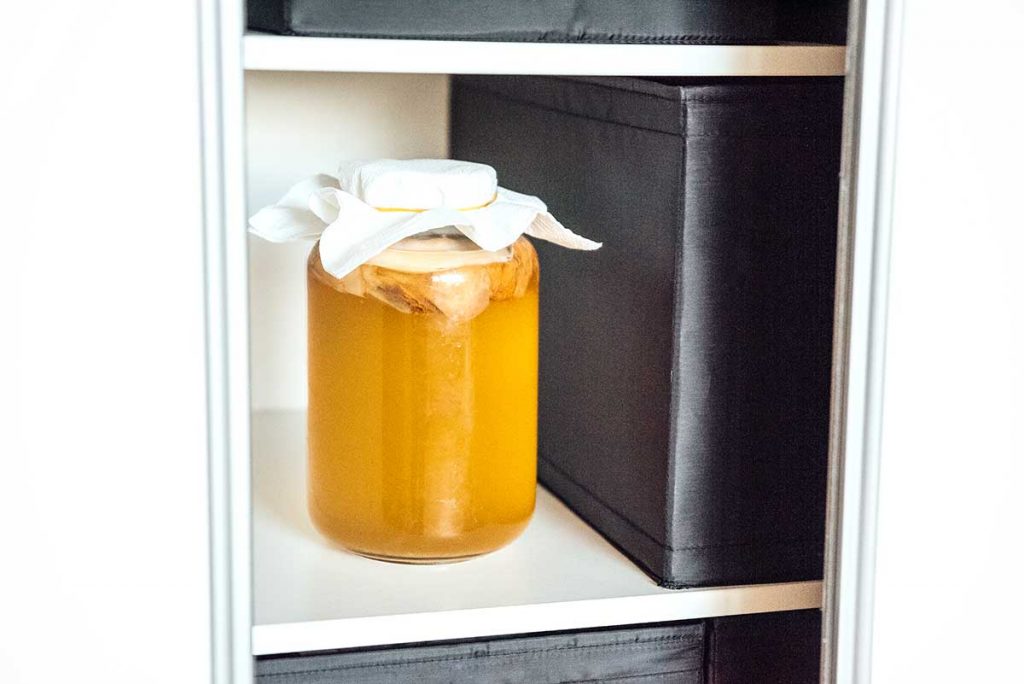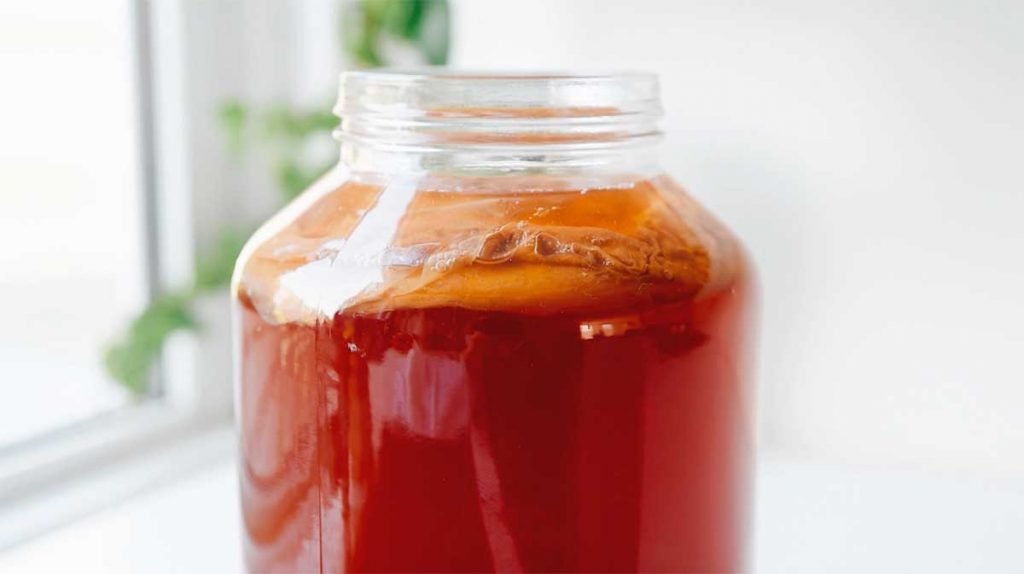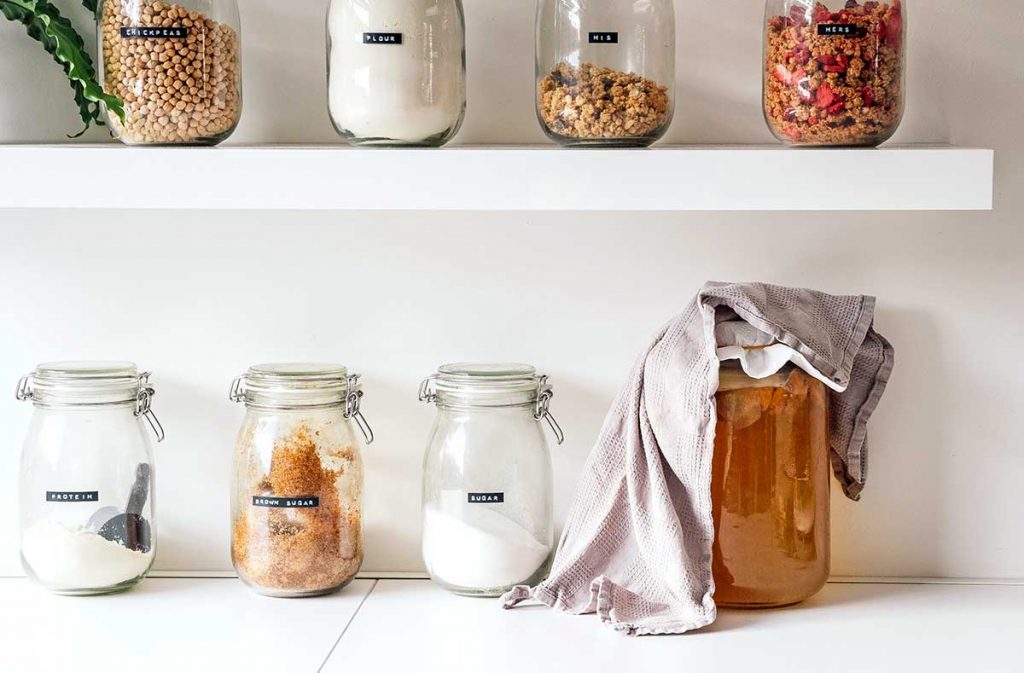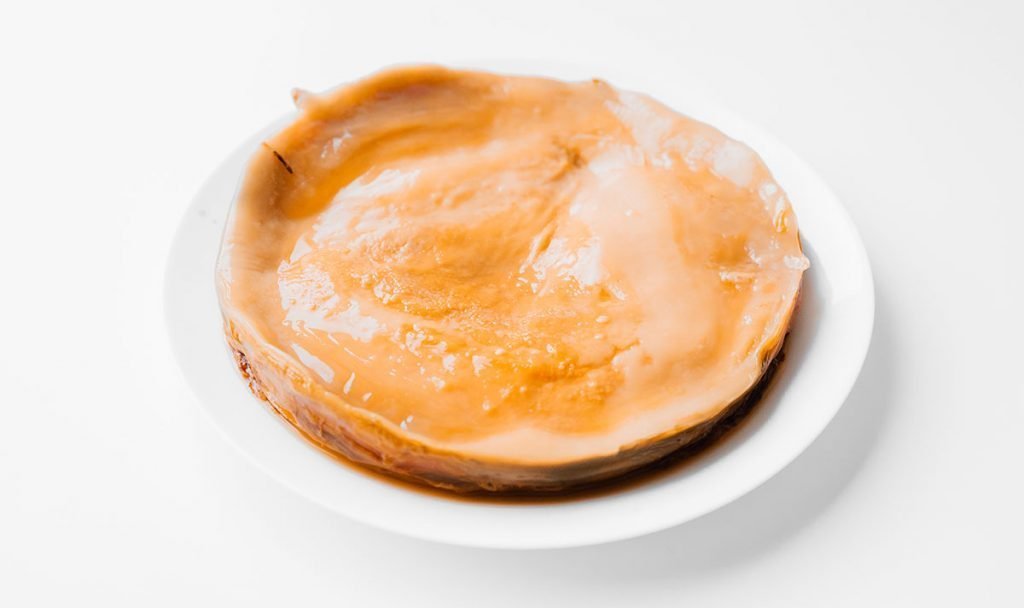Here’s how to take a break from brewing kombucha without killing your SCOBY, from short pauses to long term breaks (+ how to make a SCOBY hotel).

Anyone who has been brewing kombucha for time will agree…our kombucha SCOBY becomes a bit like a pet. We love it, we nurture it, we might even name it (????????♀️).
So what can you do to make sure Peggy (err…your SCOBY) doesn’t die while you’re on vacation? Here’s how to take a break from brewing kombucha without killing your SCOBY so she’ll live for years to come!

Storing a SCOBY between brews (1 week)
Let’s say you bottled your first fermentation kombucha, but you don’t have time to start your next first fermentation batch. You’ll need to make sure your SCOBY is stored properly until you have a chance to start your next batch.
Fortunately, this is super easy – just leave it. Leave your SCOBY and some first fermentation kombucha (i.e. your starter for the next batch) in the jar at room temperature for up to a week. (Learn the best places to store kombucha).
Short term SCOBY storage (2 to 6 weeks)
So you’re going on vacation for a few weeks and don’t want your SCOBY to die while you’re gone. For taking breaks up to 6 weeks, just feed it and leave it.
A normal first fermentation can run for 4 weeks (if the temperature is not too warm), but this can be extended to 6 weeks if needed. Start a new batch of first fermentation right before you go, which will provide enough food and nutrients for the SCOBY to eat while you’re gone.
After 6 weeks, the resulting liquid will be very acidic and vinegar tasting, but this acidity is what will protect the SCOBY from mold. Either discard the liquid or use it as a vinegar in cooking (and of course, keep some to use as a powerful starter for your next batch).

Long term SCOBY storage (6 to 12 weeks)
For taking brewing breaks longer than 6 weeks, your SCOBY is going to want occasional feedings. Brew a fresh batch of first fermentation kombucha as you would with short term SCOBY storage.
Every 6 weeks or so, drain off some of the acidic liquid and replace it with an equal amount of sweet tea (the same ratios of sugar and tea that we use in the master kombucha recipe).
If you are pressed for time, you can add just plain sugar (1 cup per gallon of kombucha), but this should only be done as a last resort, as the kombucha needs nutrients in the tea as well.
If possible, store the kombucha somewhere on the cool side for long term storage, 60-65°F (16-18°C). This will slow fermentation and allow you to stretch the time between feedings, while keeping the kombucha in a safe temperature range.

How to Make a SCOBY Hotel
You may find yourself with more SCOBYs than you can use at once. In this case, you might want to set up a SCOBY hotel.
As the name suggests, a SCOBY hotel is just a jar your extra SCOBYs can hangout until you’re ready to use them.
To make a SCOBY hotel, brew a fresh batch of first fermentation kombucha (with the same ratios of sugar, tea, and starter kombucha as in our master recipe). Cover the SCOBY hotel with a breathable cloth (no lid), then just add SCOBYs to the jar whenever you have extras. Every 4 to 6 weeks, drain off some of the liquid in the SCOBY hotel and replace it with sweetened tea so the SCOBYs can continue to have food and nutrients.
When you’re ready to use a SCOBY from the hotel, simply pluck it from the hotel (along with some of the powerful liquid it’s sitting in, which can be used as a starter). Get the full guide to SCOBY hotels here.

Things to never do when storing a kombucha SCOBY
While taking a break from brewing kombucha is easy, there are two things you should make sure don’t happen:
- Do not refrigerate your SCOBY. Cold temperature greatly increase the chance of mold and will do more harm than good.
- Do not let your SCOBY climb out. Sometimes SCOBYs like to climb up the jar and out of the liquid. If this happens, just swirl it back into the liquid so that it remains in contact with the acidic kombucha. This is its natural protection from mold!
To dehydrate or not?
While some brewers have success dehydrating SCOBYs for long (loooong) term storage, I don’t recommend this. It has a high failure rate and is often more effort than it’s worth.
If you’re taking an extended break, just bottle some strong kombucha from a first fermentation and store it in the fridge. Kombucha (without a SCOBY) will last for many months in the fridge.
When you’re ready to brew again, you’ll have a powerful starter to grow a new SCOBY from.


Having had a rest from my kombucha brewing I have just received a scoby and a small amount of kombucha from a friend. She said she hadn’t made a brew for a while, the scoby and kombucha are very dark, there is no mould but they don’t smell right to me, there is a slightly mouldy smell. Should I presume the scoby and kombucha are dead? Or should I give it a try and see what happens?
This is a tough one! With fermentations I would always just use my best judgement, and a foul odor would be a red flag for me.
How do you keep the air smelling fresh in a small apartment when brewing Kombucha? I have a very vinegar-y smell permeating the air everywhere. 🙁
That’s common! Is there a closet you could put it in? It needs air to breathe, but can be stuffed away in a closet or back room.
Can I store my scoby for a few months in the fridge, if it’s submerged in it quite vinegary liquid, and with a solid top? I’m thinking that it shouldn’t get mold in such an acidic environment and filled to the top of a quart Mason jar with a lid should keep it submerged.
Is this good reasoning?
I generally don’t advise storing in the fridge because it stops the fermentation, which can make it more susceptible to mold. But if the liquid is SUPER acidic, it could be okay!
I found both your site and revolution fermentation. You suggest doing a scoby hotel and NOT storing in the fridge. They said to store in fridge and not do a hotel! I am confused but really like the hotel idea.
Hi Dave! They both have pros and cons. While you do have to feed it more if it’s at room temp, the risk of mold goes down substantially.
I was given a scoby a few months ago but didn’t get it started until this evening. It was sitting in the fridge this whole time without me feeding it or anything. ???? it looked fine, no mold. Hopefully it turns out. Am I doomed?
I think you’ll be okay!
I had delicious kombucha several times at a friend’s house in Florida. Before I returned to Wisconsin, she gifted me with a jar of what she called a “placenta.” It doesn’t look anything like a scoby; it looks like, well, what I imagine a placenta looks like! It apparently works well for her kombucha, and I’d like to know if it’s the same thing as a scoby.
I’m about to make my first batch. If it doesn’t work I’ll start from scratch with a new onw.
Thanks much,
SCOBYs can look like a whole range of things, so I bet it’s a SCOBY! Really all you need though is some started kombucha to get going (i.e. just unflavored kombucha).
I bought a scoby back in July 2021 and never got a chance to use it. I was under the impression that I should leave it at room temp so I did but didn’t realize I needed to feed it. Do you think they’re still any good assuming there’s no mold? Is there any way to tell from its visible appearance.?
If there’s no mold and there’s still liquid in the jar, it should be okay!
I made not 1st gallon of tea w/ so by. It has been 10 days. I now have to go out of town for a month. Can I put it into the flip top bottles and refrigerate it for a month? Will the bottles explode in the fridge? Or would you recommend a different process like leaving the gallon jug as is or put it in the fridge for a month. Confused in St. Louis
The bottles should be fine in the fridge! They’ll stop fermenting in there, so you shouldn’t have to worry about explosions.
I need to take a VERY longterm break from my homebrew because I am pregnant! What do you recommend? Just feeding my batch every month or so with some more sweet tea and draining out the existing liquid? How much sweet tea do you need to add (ratios, etc?). Thank you!!!
Congrats!! Yep that’s exactly what I would do. You can essentially make a new batch every 1 to 2 months, reserving 2 cups of starter and replacing the rest with sweet tea.
I’ve left my scoby for a long time – maybe 6 months or more – it looks dormant and healthy. I made the scoby like I was going to make kombucha and then just left it all this time. Can I just revive it like it’s in a scoby hotel? Can I use the super acidic kombucha it’s been sitting in?
Yep, you should be able to use it! And that liquid should also work as starter! 😀
Hi! So grateful to find this website. I took a looong break from brewing kombucha, and I’ve stored all my SCOBY in the fridge for several months now. I’d never have problems brewing with the SCOBY taken from the fridge before, but maybe this time I’ve left them in there too long, the new batch I made doesn’t have baby scoby formed on top after 14 days. There’s no mold or anything and it smells just like kombucha. What should I do to
revive my scoby? and what should I do with this batch of kombucha?
How does it taste? I would think it’s good to go if the taste is right!
Hi, I’ve taken a break from my brewing as I had sooo much, I’ve stored the bottles of brew in cool place, will they be ok to drink now, maybe 6months later. Also I haven’t fed my scoby, she’s just been in what tea was left. Could I start her up again? She looks clean, soft, no mould.
They may be too tart to drink, but they should be safe to drink if that’s the question! And SCOBY should be fine to use again 😀
After leaving the tea in the first fermentation way too long, would you recommend that I start a new batch with some of that (overly vinegary) first fermentation tea as starter tea, or should I add some new store-bought raw kombucha to add as the starter?
Use the vingery old tea! It should be full of bacteria and yeast 😀
Oh boy, I’m learning a lot of things I didn’t know when I made my first batch. I have my scobies in two mason jars in my cabinet with lids on. It’s been 3 months ???? Do you think they’re okay to use again? I didn’t know I had to feed them ????
They could be okay, as long as you don’t see any signs of mold! 😀
OK cool! (The baggies weren’t stored in the fridge for those 5 and a half months… )
Hi,
I made some Scoby’s from store bought quality kombucha last year. Then I stored them in small ‘baggies’ with a little bit of liquid. They were probably stored for around… 5 or 5 and a half months like that. The other day I made a big batch of sweet tea and poured it into a large mason jar, along with the scobys and their starter liquid. They didn’t look mouldy or anything. I wonder if they were dead though?
Anyway a thin layer of scoby started to form on the top of the tea in the jar, and the old scobys stayed at the bottom. I decanted about 600mls of the stuff off a couple of days ago and it is now undergoing its second ferment. It tasted quite vinegary, and also quite sweet still, after 2 weeks of ‘primary’ fermantation. Do you think it’s OK that I used these ‘old’ scobies like this? I haven’t had any bad reactions from drinking the fresh kombucha, although I msut say I’ve not drunk much of it.
I can keep you updated on how things go, if you wish. Might throw some light on storing options for scobys.
Best wishes,
Charlie
They should be fine! It’s normal for them to sink or float around the jar. Curious to hear how it goes! 😀
Is it okay to refrigerate the sweet tea to speed up the cooling process?
Yep! 😀
My Scoby has got so big and fast, it won’t fit out through the mouth of the jar. I usually take it out to get the liquid out. It’s so think I couldn’t even separate it. Will I damage her if I tear or cut her?
You can tear or cut it if needed! What a big mama! 😀
Can you use fresh pineapple in the second fermentation.
Yep! Here’s our Pineapple Kombucha recipe.
I have not been having luck with my 1st batch or even my hotel. Mold has been growing in the past 3 batches. I just added brew tea and sugar to the hotel 7 cup of tea 1 cup of sugar. Temp was fine but I see black mold growing? I had about 3-4 inches of scoby. If I have to chuck it out can I keep the scobies?? HELP
If there is mold you’ll unfortunately need to throw away everything, SCOBY included. Clean your supplies very very well then try again. Just to be sure, I would add extra starter kombucha (unflavored kombucha) to your next batch to get the acidity high. Acidity will help prevent mold!
14 cups of water to 1 cup sugar is what I use
7 cups makes it way too sweet
sugar grows mold
8 tea bags (strong black tea)
Rinse all your jars and bottles out with white vinegar to clean well
Rinse your hands in white vinegar before you touch anything, especially the scoby
Hi, do I throw away the mother scoby as it get too thick and look dirty. It had been used to ferment a couple times.
Can I separate the baby from the mother and just use the baby scoby for next fermentation?
Thank you so so much fir your advice.
You can separate the baby and use it for another fermentation, but no need to throw away the mother. It can last for years! Gift it to a friend, use it to start another batch, put it in a SCOBY hotel, or even make candy with it.
I was just gifted a scoby a little over a week ago and the indivdual who brought it to me put it in the fridge…. its been in there since because I am just now looking into how to begin my first batch. Should I take this out of the fridge at this point? Also, I think the person told me I have a momma scoby and a baby scoby in this jar… what do I do with two? I am brand new at this obviously.. lol any help would be very much appreciated 🙂
Yep, take them out of the fridge and start brewing with them! I would throw both into the same jar and use them together until you get the hang of brewing (then you can separate them into two jars to have two batches going at once).
Thank you for this! I started brewing in June and have done probably 4 really successful brews from your guide (amazing!!) but it’s nice to see that just how I’m doing it she can probably last a bit longer between brews so I don’t feel as rushed.
Absolutely! So happy it’s going well for ya. Happy brewing!
Hi there and Happy Monday to you : )
I was gifted a scoby about 3 weeks ago now and its just been sitting in my pantry since then waiting for me to take action. It’s just had a coffee filter sitting over the jar top fixed with a rubber band.
Do you think I might have to start over? I know it’s probably hard to tell without a photo.
Any help would be greatly appreciated.
So fun that you got 3 new babies! They should be just fine to use. You can start on the first fermentation 😀
Scooby loves to be fed every seven days. Then I use pineapple pieces to second ferment one to two days on the shelf in the laundry closet. The fizzy is off the charts. When I’m ready for some boocha I just dump a bottle into a quart jar and add a straw. Yummylicious. Love those pineapple tidbits too. Thanks for your free pdf, it really helped take it to the next level. Now this info will be very good as the whole covid thingy has Alaskans running off with everything at Wallies as though they’re not getting anymore. Bout to run out of sugar. Boo
I’ve been putting my scoby in the frig, but have not seen mold.. however, when I first got my scoby from my friend in Istanbul (it was in her frig), my kombucha had the familiar taste, but, with each batch it got milder and milder and now has hardly any of the familiar flavor, although it gets very fizzy. Any way to get the magic back? 🙁
Hmm that’s strange! Perhaps use a bit more starter kombucha to give it more fermenting power, along with a few more tea bags to strengthen the flavor. The fizz is a good sign though – clearly something is happening in there! And I’m not sure if you’re storing it in the fridge currently, but definitely take it out if you are and let it ferment at room temp.
Hi Sarah. I did too many bottle of kombucha and I looked it up on uncle Googs (that what i call Google) on how to take a break and I followed (I dont no who) and that was to make a new batch, which was not to fill my jar, but just to feed my scoby then put cheese cloth over the top and put an air tight lid on it. This was for about 4 to 5 weeks and when I was ready to do a new batch, took it out and started again. Turned out as if I never had a break. Just thought I would share this with you.
ps. It was summer at the time.
Thanks so much for the tip, Valentine! I’ll have to try this out next time I take a break 😀
Oh my…I had a HUGE Scoby in my jar when I bottled yesterday! (about an inch thick) I sure wish I had known that I could put her in a hotel!
I tore off a slab for my new jar and geave the rest to my chickens. Next time I’ll try this.
Fortunately it will just keep growing! Happy chickens at least ????